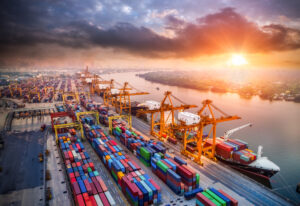The EPA on October 31 hosted a two-hour webinar entitled “EPA Clean Ports Program—First Look!” The Clean Ports Program invests $3 billion in technologies to reduce harmful air and climate pollutants at U.S. ports and to create a zero-emission (ZE) shipping future.
“This new funding program will build on EPA’s Ports Initiative that helps our nation’s ports, a critical part of our infrastructure and supply chain, address public health and environmental impacts on surrounding communities,” according to the EPA Clean Ports Program website. “EPA anticipates this new funding opportunity will become available for application through a notice of funding opportunity (NOFO) released in late winter 2024.”
Goals
The goals of the Clean Ports Program are:
- Reduce diesel pollution (criteria pollutants, greenhouse gases (GHG), and air toxics) in near-port communities, with a deliberate focus on those with environmental justice concerns. Maximize ZE technology deployment, and provide funding for a limited amount of infrastructure to deliver near-term emissions reductions.
- Build a foundation for the port sector to transition over time to fully ZE operations using domestically produced equipment, positioning ports to serve as a catalyst for transformational change across the freight sector.
- Help ensure meaningful community engagement and emissions reduction planning are port industry standard practices. The program seeks to build the capacity of ports to continue to make strategic clean air and climate investments into the future and ensure some amount of geographic and port type diversity to transition the entire sector.
Sub-programs
The Clean Ports Program has two sub-programs:
- Climate and air quality planning: The Agency says this program is better suited for applicants who haven’t yet done any planning work.
- ZE technology deployment (equipment and infrastructure): This program is for applicants who have done planning work and are determining the correct technology needed at their port.
“However, they emphasized that those interested may apply to both, and they anticipate many will,” notes Holland & Knight LLP.
The EPA’s focus is on “ZE technologies and related fueling infrastructure operating at ports, including drayage trucks, switcher locomotives, cargo-handling equipment, harbor craft and shore power for ocean-going vessels,” Holland & Knight continues. “[The EPA] expressed a desire to see current technology operating at ports, such as internal combustion engines and diesel engines, move to ZE technologies with the capacity to serve the same purpose.”
Funding opportunities
Eligible recipients for funding include:
- Port authorities;
- State, regional, local, or tribal agencies that have jurisdiction over a port authority or port;
- Air pollution control agencies; and
- Private entities that:
- Apply for a grant in partnership with an eligible entity above; and
- Own, operate, or use the facilities, cargo-handling equipment, transportation equipment, or related technology of a port.
Another significant announcement in the webinar was the EPA’s intent to include “dry ports,” such as intermodal facilities dealing with rail-truck transfers, which creates industry concern that funding resources will be diverted from seaports.
“With regard to zero-emission technology (ZET) grants, EPA staff explained that it is their intent to fund a handful of mega projects in the $200 million-$500 million range. They will also fund many smaller projects but will require all projects to be at least $10 million in cost. The agency has not yet announced a cost share requirement but is thinking of a 10%-20% non-federal cost share,” the American Journal of Transportation (AJOT) says. “With regard to planning activities, the agency will require grant applications to be at least $100,000 and no more than $3 million. There will be no cost share requirement for planning grants.”
EPA staff also stressed that only one funding round will be provided, so there won’t be additional funding available through this program for implementation phases.
“Federal assistance for implementation will have to be pursued from other federal programs (there are several) or from non-federal sources,” the AJOT reports. “There is an option to pursue a joint planning/implementation grant from this program (which will be allowed). However, such a strategy would require considerable advance preparation.”
“EPA repeatedly stressed that community engagement will be required for all successful grant applications with an emphasis on environmental justice communities. EPA urged all those considering application to this program to begin working now to engage near-port communities in project development.”
Timeline
The anticipated timeline for the Clean Ports Program is:
- Release of NOFO: February 2024
- NOFO closes: May 2024
- Applicants selected: September 2024
- Grants awarded: December 2024
See the EPA Clean Ports Funding website for more information.

